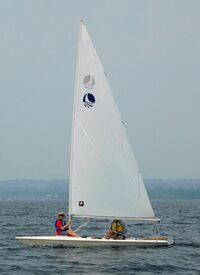Engineering:Bombardier Invitation
 Class symbol | |
 | |
| Development | |
|---|---|
| Location | Canada |
| Year | 1973 |
| Design | Bombardier Research |
| Builder(s) | Bombardier Limited |
| Role | One-design racer |
| Boat | |
| Boat weight | 181 lb (82 kg) |
| Draft | 2.99 ft (0.91 m) with the daggerboard down |
| Hull | |
| Type | Monohull |
| Construction | Fibreglass |
| LOA | 15.58 ft (4.75 m) |
| Beam | 4.92 ft (1.50 m) |
| Hull appendages | |
| Keel/board type | daggerboard |
| Rudder(s) | transom-mounted rudder |
| Rig | |
| Rig type | Cat rig |
| Sails | |
| Sailplan | Catboat |
| Mainsail area | 90.00 sq ft (8.361 m2) |
| Total sail area | 90.00 sq ft (8.361 m2) |
| Racing | |
| D-PN | 99.3 |
|
| |
The Bombardier Invitation is a Canadian sailing dinghy that was designed by Bombardier Research to compete in the same market with the Laser, as a one-design racer. It was first built in 1973.[1][2]
The design was developed into the Bombardier 3.8 in 1974.[3]
Production
The design was built by Bombardier Limited in Canada starting in 1973, but it is now out of production.[1][2][4]
Bombardier Limited applied for a trademark of the Invitation name, for "boats and parts", on 7 December 1973. The trademark was granted on 15 November 1974, but expired on 12 January 1990 and was not renewed.[5]
Design
The Invitation is a recreational sailboat, built predominantly of fibreglass, with wood trim. It has a catboat rig with aluminum spars and a loose-footed mainsail. The hull has built-in foam for buoyancy. The sail is without sail battens, is installed over the two-piece mast with a sewn-in sleeve and can be wrapped around the mast. The hull has an enclosed foredeck, a spooned raked stem, a vertical transom, a wooden, kick-up, transom-hung rudder controlled by a tiller with a hiking stick and a retractable wooden daggerboard. The hull alone displaces 180 lb (82 kg).[1][2]
The boat has a draft of 2.99 ft (0.91 m) with the daggerboard extended. Retracting the daggerboard allows beaching or ground transportation on a trailer or car roof rack.[1]
For sailing the design is equipped with hiking straps, an adjustable outhaul, a boom vang and a vacuum bailer.[2]
The design has a Portsmouth Yardstick racing average handicap of 99.3 and is normally raced with a crew of one or two sailors.[2]
Operational history
In a 1994 review Richard Sherwood described the Invitation as, "a boat designed for ease in cartopping, with two-piece mast and overhanging two-inch gunwale to assist lifting ... [the] Invitation is a one-design with rigid class rules."[2]
See also
Related development
Similar sailboats
References
- ↑ 1.0 1.1 1.2 1.3 McArthur, Bruce (2020). "Bombardier Invitation sailboat". sailboatdata.com. https://sailboatdata.com/sailboat/bombardier-invitation.
- ↑ 2.0 2.1 2.2 2.3 2.4 2.5 Sherwood, Richard M.: A Field Guide to Sailboats of North America, Second Edition, pages 58-59. Houghton Mifflin Company, 1994. ISBN:0-395-65239-1
- ↑ Browning, Randy (2020). "Bombardier 3.8 sailboat specifications and details". sailboatdata.com. https://sailboatdata.com/sailboat/bombardier-38.
- ↑ McArthur, Bruce (2020). "Bombardier Ltd. (CAN)". sailboatdata.com. https://sailboatdata.com/builder/bombardier-ltd-can.
- ↑ Industry Canada (12 January 1990). "Invitation — 0370634". Canadian Trademarks Database. http://www.ic.gc.ca/app/opic-cipo/trdmrks/srch/viewTrademark.html?id=0370634&lang=eng.
External links
 |

